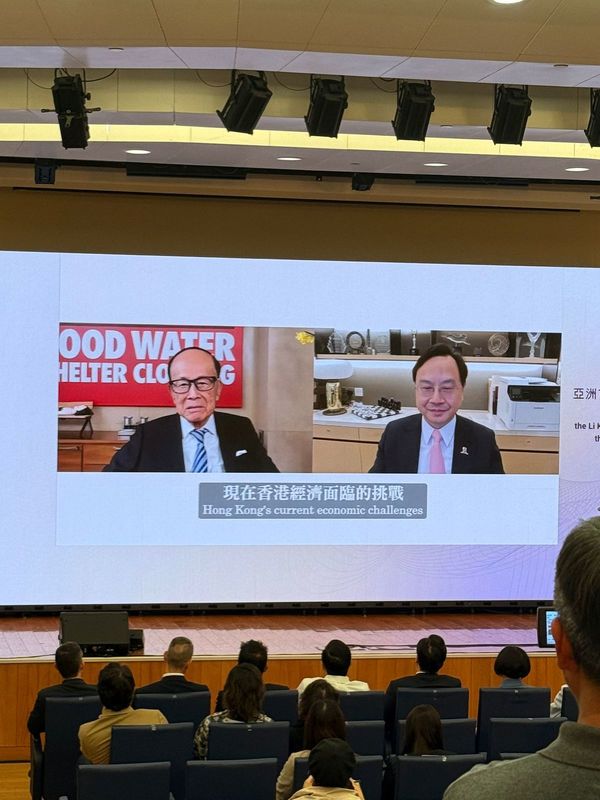▲ Li Ka-shing appeared | .
- Li Ka-shing donates tissue disruption technology and new cancer treatment equipment to CUHK
- Li Ka-shing makes light comments about Hong Kong’s economy
The Chinese University College of Hong Kong has received Asia’s first Histotripsy 2.0 system donated by the Li Ka-shing Foundation and will begin treating patients early next year. The Li Ka Shing Foundation will donate 10 liver cancer patients to receive tissue morcellation technology, while the CUHK Faculty of Medicine and the Prince of Wales Hospital Charitable Trust will support a further 20 patients. CUHK held a press conference today to present new instruments to the Li Ka-shing Foundation.
During the video interview, Li Ka-shing congratulated Lo Yuk-ming on taking over as President of CUHK in January 2025. He sighed:
The challenges facing Hong Kong’s economy today cannot be met through simple investment.
I have always believed that in-depth research into how to use medical technology has multiple meanings.

Lu Yuming replied that his team has been working hard in recent years to develop low-cost cancer screening methods to diagnose patients as early as possible. He hopes that this new technology can be used to serve the people of China and Southeast Asia first.
Li Ka-shing also pointed out that this is why he decided to donate three medical devices to the Chinese University of Hong Kong, Hong Kong University and Sanatorium and Hospital after learning that the treatment method at the High- Professor Xu Zhen from the University of Michigan agreed, hoping that joint research would begin as soon as possible. He also explained:
Tissue breaking technology (Histotripsy) is like a technological gift, a gift that brings hope, health and life to society. Within 90 days after the first Histotripsy system arrived in Hong Kong, 30 liver cancer patients were successfully treated. This new low-cost, high-efficiency cancer treatment option can not only greatly reduce the financial burden on patients’ families, but also relieve the financial burden of public medical services on the government in a society that getting older.
According to CUHK, Histotripsy 2.0 is equipped with the most advanced system engine in the world and is compatible with more functions for continuous system upgrades. This system can continuously receive feedback information during the ablation process, improve the efficiency of tumor ablation, and lay a solid foundation for using tissue disruption technology in different parts of the body to achieve different treat cancers.
2024-11-19 09:13:00
#Kashing #appeared

What specific strategies can universities and the medical community employ to navigate economic challenges in Hong Kong while continuing to advance healthcare initiatives?
1. As a professional website editor, I would like to congratulate you on receiving these groundbreaking medical devices from the Li Ka-shing Foundation. Could you please tell us more about the potential impact of these technologies on not only the medical field but also on society as a whole?
2. Mr. Li Ka-shing has also expressed his concerns about the current economy of Hong Kong. What do you think are some of the challenges that the university and medical community face in response to these concerns, and how can they work together to address them?
3. The donation of these devices to three different institutions indicates a strategic plan by the Li Ka-shing Foundation. Could you discuss the rationale behind this decision, and how it will contribute to broader access to healthcare in the region?
4. The treatment method being developed by Professor Xu Zhen from the University of Michigan seems promising, and it’s great to hear that collaboration will be ongoing. How do you envision these partnerships shaping the future of cancer research and treatment?
5. Histotripsy 2.0 is a highly advanced system with potential for continuous upgrades and improvements. Can you elaborate on some of the specific advantages it offers over existing medical technologies for cancer treatment, and what kind of research do you hope to undertake using this new technology?
6. The cost-effectiveness of this treatment method is particularly noteworthy. How do you plan to ensure that this technology reaches a wide range of patients who may not have access to it otherwise, and how can we address potential disparities in healthcare access in the region?
7. what message would you like to send out to the public about the importance of collaboration between the private sector, academia, and healthcare providers in driving innovation and improving health outcomes?

